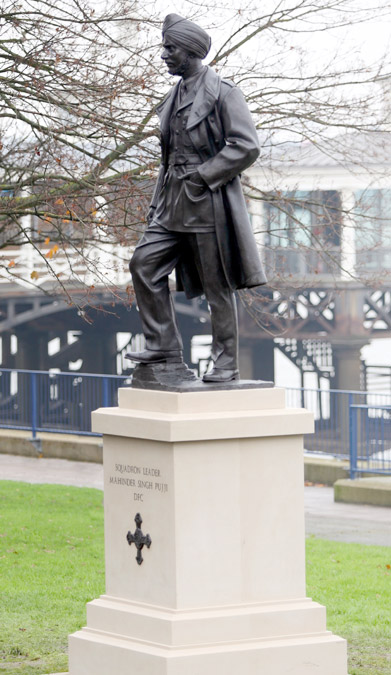
I have been wanting to write about the military heroes of the 20th century from India. We have so many great soldiers and airmen who are not remembered in India and one of them is Squadron Leader Mahinder Singh Pujji. He was ace pilot who fought in the Second World War and saw action in both the European and Burma theatre. Pujji migrated later to England after the war and settled in Gravesend close to London. I have been to London, which is almost like a second home to me as more than half of my immediate family is settled there and I always wanted to visit Gravesend. I got my chance in 2011 and visited the place. I wanted to visit the place, basically to see how the English honor the men who served in the war. In fact I wanted to see the statue of MS Pujji which adorns the small city.It's something Indians can emulate.
The statue is there and I was delighted to see it. It is sculpted in black stone and is a tribute to one of the great fliers. Pujji was born in 1910 in Quetta ( now in Pakistan) and had his early education in India. he always loved to fly and learnt flying in Delhi. After that he joined the Royal Air Force .Pujji saw action during the Battle of Britain (1940). This was prelude to Hitlers plan for the invasion of England code named " Operation Sea Lion". As is well known the Luftwaffe was defeated and Indian pilots like Pujji played no mean part in stopping the Luftwaffe.
In 1943, he was transferred to Burma to take on the rapid advance of the Japanese Imperial army. He did a great job in covering the retreat of the British Indian army and was awarded a DFC. Pujji left the RAF after the war and took up a job at Delhi.. But he found the situation in India staid after the war and independence and as he had served in the RAF he migrated to England where he died in 2010. I don't think anybody knows about him in India and in the Air Force Museum at Palam , I find no mention of Pujji. This is sad as all fighters must be honored. Yes, Pujji fought for the King, but then 2. 5 million men did the same. India at that owed allegiance to the King, so there can be no stigma in fighting for the King. The important thing is to remember the quality of a soldier and appreciate it.
The Royal Air Force however remembered him and after his death his statue is placed at the place where he spent the last years of his life. He was also honored at the opening of a section of the Royal Air Force Museum dedicated to Indian pilots , when he was asked to inaugurate it. In India we have no tradition of honoring our soldiers after independence and shows that as a nation we have as yet miles to go.
Photo of statue at Gravesend from wiki free commons